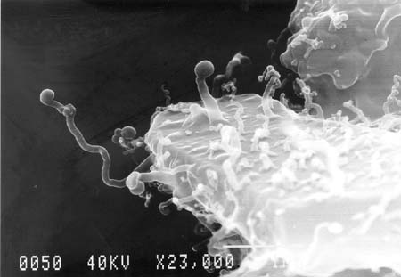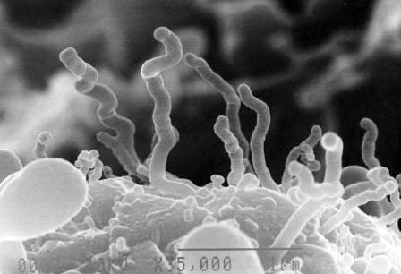
Nanobe
Encyclopedia

Structure
Structure is a fundamental, tangible or intangible notion referring to the recognition, observation, nature, and permanence of patterns and relationships of entities. This notion may itself be an object, such as a built structure, or an attribute, such as the structure of society...
first found in some rocks
Rock (geology)
In geology, rock or stone is a naturally occurring solid aggregate of minerals and/or mineraloids.The Earth's outer solid layer, the lithosphere, is made of rock. In general rocks are of three types, namely, igneous, sedimentary, and metamorphic...
and sediment
Sediment
Sediment is naturally occurring material that is broken down by processes of weathering and erosion, and is subsequently transported by the action of fluids such as wind, water, or ice, and/or by the force of gravity acting on the particle itself....
s. Some scientists hypothesize
Hypothesis
A hypothesis is a proposed explanation for a phenomenon. The term derives from the Greek, ὑποτιθέναι – hypotithenai meaning "to put under" or "to suppose". For a hypothesis to be put forward as a scientific hypothesis, the scientific method requires that one can test it...
that nanobes are the smallest form of life
Life
Life is a characteristic that distinguishes objects that have signaling and self-sustaining processes from those that do not, either because such functions have ceased , or else because they lack such functions and are classified as inanimate...
, 1/10 the size of the smallest known bacteria. No conclusive evidence exists for whether these structures are, or are not, living organisms, and their classification is controversial.
Nanobes were discovered in 1996 (published in American Mineralogist
American Mineralogist
American Mineralogist is the peer-reviewed journal of the Mineralogical Society of America , a non-profit association. It publishes original scientific research in the general fields of mineralogy, crystallography, geochemistry, and petrology....
, vol 83., 1998) by Philippa Uwins, University of Queensland
University of Queensland
The University of Queensland, also known as UQ, is a public university located in state of Queensland, Australia. Founded in 1909, it is the oldest and largest university in Queensland and the fifth oldest in the nation...
, Australia
Australia
Australia , officially the Commonwealth of Australia, is a country in the Southern Hemisphere comprising the mainland of the Australian continent, the island of Tasmania, and numerous smaller islands in the Indian and Pacific Oceans. It is the world's sixth-largest country by total area...
. They were found growing from rock samples (both full-diameter and sidewall cores) of Jurassic
Jurassic
The Jurassic is a geologic period and system that extends from about Mya to Mya, that is, from the end of the Triassic to the beginning of the Cretaceous. The Jurassic constitutes the middle period of the Mesozoic era, also known as the age of reptiles. The start of the period is marked by...
and Triassic
Triassic
The Triassic is a geologic period and system that extends from about 250 to 200 Mya . As the first period of the Mesozoic Era, the Triassic follows the Permian and is followed by the Jurassic. Both the start and end of the Triassic are marked by major extinction events...
sandstones, originally retrieved from an unspecified number of oil exploration
Oil exploration
Hydrocarbon exploration is the search by petroleum geologists and geophysicists for hydrocarbon deposits beneath the Earth's surface, such as oil and natural gas...
wells off Australia's west coast. Depths of retrieval were between 3400 metres (2.1 mi) and 5100 metres (3.2 mi) below the sea bed. While Uwins et al. present assertions against it, they do not exclude the possibility that the nanobes are from a surface contaminant, not from the rock units cited.
The smallest are just 20 nanometers
Nanometre
A nanometre is a unit of length in the metric system, equal to one billionth of a metre. The name combines the SI prefix nano- with the parent unit name metre .The nanometre is often used to express dimensions on the atomic scale: the diameter...
in diameter. Some researchers believe that these structures are crystal
Crystal
A crystal or crystalline solid is a solid material whose constituent atoms, molecules, or ions are arranged in an orderly repeating pattern extending in all three spatial dimensions. The scientific study of crystals and crystal formation is known as crystallography...
growths, but the staining of these structures with dyes that bind to DNA
DNA
Deoxyribonucleic acid is a nucleic acid that contains the genetic instructions used in the development and functioning of all known living organisms . The DNA segments that carry this genetic information are called genes, but other DNA sequences have structural purposes, or are involved in...
might indicate that they are living organisms. They are similar to the structures found in ALH84001
ALH84001
Allan Hills 84001 is a meteorite that was found in Allan Hills, Antarctica on December 27, 1984 by a team of U.S. meteorite hunters from the ANSMET project. Like other members of the group of SNCs , ALH 84001 is thought to be from Mars. However, it does not fit into any of the previously...
, a Mars meteorite
Mars meteorite
A martian meteorite is a rock that formed on the planet Mars, was ejected from Mars by the impact of an asteroid or comet, and landed on the Earth. Of over 53000 meteorites that have been found on Earth, 99 are martian...
found in the Antarctic. Recently there has been some interest amongst bio-tech
Biotechnology
Biotechnology is a field of applied biology that involves the use of living organisms and bioprocesses in engineering, technology, medicine and other fields requiring bioproducts. Biotechnology also utilizes these products for manufacturing purpose...
companies in commercial application of nanobes in utilization of plastic
Plastic
A plastic material is any of a wide range of synthetic or semi-synthetic organic solids used in the manufacture of industrial products. Plastics are typically polymers of high molecular mass, and may contain other substances to improve performance and/or reduce production costs...
s.
Nanobes are similar in size to nanobacteria, which are also structures that have been proposed to be extremely small living organisms. However, these two should not be confused. Nanobacteria are supposed to be cellular organisms, while nanobes are hypothesized to be a previously unknown form of life or protobiont
Protobiont
Protobionts are systems that are considered to have possibly been the precursors to prokaryotic cells. If RNA is trapped inside, the system can use the RNA or select for it....
s.
Claims

- It is a living organism (contains DNADNADeoxyribonucleic acid is a nucleic acid that contains the genetic instructions used in the development and functioning of all known living organisms . The DNA segments that carry this genetic information are called genes, but other DNA sequences have structural purposes, or are involved in...
or some analogue, and reproduces). - Has a morphology similar to Actinomycetes and fungi.
- Nanobes are about 20 nmNanometreA nanometre is a unit of length in the metric system, equal to one billionth of a metre. The name combines the SI prefix nano- with the parent unit name metre .The nanometre is often used to express dimensions on the atomic scale: the diameter...
in diameter, which may be too small to contain the basic elements for an organism to exist (DNA, ribosomes, etc.), suggesting that if they grow and reproduce they would need to do so in an unconventional way. - The Martian meteorite ALH84001ALH84001Allan Hills 84001 is a meteorite that was found in Allan Hills, Antarctica on December 27, 1984 by a team of U.S. meteorite hunters from the ANSMET project. Like other members of the group of SNCs , ALH 84001 is thought to be from Mars. However, it does not fit into any of the previously...
, discovered in 1984 in the AntarcticAntarcticThe Antarctic is the region around the Earth's South Pole, opposite the Arctic region around the North Pole. The Antarctic comprises the continent of Antarctica and the ice shelves, waters and island territories in the Southern Ocean situated south of the Antarctic Convergence...
, contained similar tubular structures which some astrobiologistsAstrobiologyAstrobiology is the study of the origin, evolution, distribution, and future of life in the universe. This interdisciplinary field encompasses the search for habitable environments in our Solar System and habitable planets outside our Solar System, the search for evidence of prebiotic chemistry,...
suggested could be evidence of life at an earlier time on MarsMarsMars is the fourth planet from the Sun in the Solar System. The planet is named after the Roman god of war, Mars. It is often described as the "Red Planet", as the iron oxide prevalent on its surface gives it a reddish appearance...
.
Responses
A review in Microbes and Environments of the various ultra-small forms of proposed life stated that the main criticism of nanobes is that they appear too small to contain the biochemical machinery needed to sustain life. The review also stated that there is no evidence that nanobes are organisms in themselves and not fragments of larger organisms.See also
- UltramicrobacteriaUltramicrobacteriaUltramicrobacteria are bacteria that are considerably smaller than normal bacterial cells and are 0.3 to 0.2 micrometres in diameter. This term was first used in 1981, to refer to cocci in seawater that were less than 0.3 μm in diameter. These cells have also been recovered from soil and appeared...
- Mycoplasma genitaliumMycoplasma genitaliumMycoplasma genitalium is a small parasitic bacterium that lives on the ciliated epithelial cells of the primate genital and respiratory tracts. M. genitalium is the smallest known genome that can constitute a cell, and the second-smallest bacterium after the recently-discovered endosymbiont...
, Pelagibacter ubiquePelagibacter ubiquePelagibacter, with the single species P. ubique, was isolated in 2002 and given a specific name, although it has not yet been validly published according to the bacteriological code. It is an abundant member of the SAR11 clade in the phylum Alphaproteobacteria...
— some of the smallest known bacteria - NanoarchaeumNanoarchaeumNanoarchaeum equitans is a species of tiny microbe, discovered in 2002 in a hydrothermal vent off the coast of Iceland by Karl Stetter. Since it grows in temperatures approaching boiling, it is considered to be a thermophile. Nanoarchaeum appears to be an obligatory symbiont on the archaeon...
— smallest known archaeum - MimivirusMimivirusMimivirus is a viral genus containing a single identified species named Acanthamoeba polyphaga mimivirus , or is a group of phylogenetically related large viruses . In colloquial speech, APMV is more commonly referred to as just “mimivirus”...
— one of the largest known virusVirusA virus is a small infectious agent that can replicate only inside the living cells of organisms. Viruses infect all types of organisms, from animals and plants to bacteria and archaea...
es - ParvovirusParvovirusParvovirus, often truncated to "parvo", is both the common name in English casually applied to all the viruses in the Parvoviridae taxonomic family, and also the taxonomic name of the Parvovirus genus within the Parvoviridae family...
— family of the smallest known viruses - NanobacteriumNanobacteriumNanobacterium is the unit or member name of a proposed class of living organisms, specifically cell-walled microorganisms with a size much smaller than the generally accepted lower limit size for life...
– another proposed class of living organisms
External links
- Color photo of a nanobe colony
- Definition of nanobe
- Introduction to nanobes
- "Nanobes: A New Form of Life?"
- Nanobe images and links
- Transcript of interview of Philippa Uwins
- Size Limits of Very Small Microorganisms Proceedings of a Workshop organized by the National Academies of Sciences
- How Small Can Life Be? on NAI news.

